Thousands of islands make up the Philippines, where bustling cities, underwater gardens and lushly beautiful landscapes await travellers who seek a textured Southeast Asian adventure. Lovers of surfing, world-class dive sites and the perfect setting for carefree, beach-flopping days can expect all of the above, along with the richest of cultural experiences.Manila is the gateway to the country, and is home to a fascinating urban energy, as well as marvellous, Spanish-colonial buildings and cathedrals. Visitors will also find wonderful museums. Island hopping around the archipelago carries a storybook feeling, brought on by the delight of sailing teal seas to gorgeous, jungle-like beaches. The country's many remote, unspoilt regions have a different sort of magnetism, and will speak to hikers and adventure seekers.All things considered, the Philippines has much to offer, though tourists should follow the safety advice of travel experts when visiting.
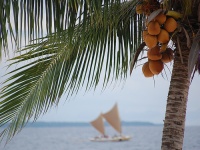
The island province of Bohol lies southeast of Cebu and is one of the loveliest destinations in the Visayas island group. Travellers will find tremendous natural attractions, such as the world's rarest seashells. Animal lovers should look out for the tarsier, which is a huge-eyed, insect-eating monkey. When fully grown, it's roughly the size of a fist. Visitors will also enjoy the world-famous Chocolate Hills. The surreal series of between 1200 and 1800 hills resembles scoops of chocolate ice-cream and is Bohol's greatest natural attraction. The weathering of coral deposits formed it many millennia ago, when the land was still beneath the sea. Otherwise, visitors can look forward to the region's glorious beaches and top-class scuba-diving sites. Indeed, Panglao Island frequently graces lists of the world's top ten diving destinations.
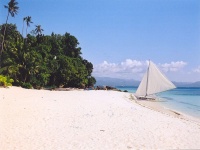
Located in the western Visayas, the tiny, butterfly-shaped island of Boracay is a major hotspot for international sun-lovers. Its powder-white, palm-studded beach is said to glow at night. Holidaymakers will appreciate the island's unspoilt beauty, along with its hotels, guesthouses, restaurants and fun nightlife. They can also enjoy an array of water sports, such as cliff diving, kiteboarding, snorkelling, windsurfing, and scuba diving. Boracay has rightly won multiple awards and deserves its place among the world's top beach resort destinations. The best time to visit is during the Amihan season (between October and May), when there is little to no rain, and the prevailing wind blows from the east, leaving the island's western region (the main tourist area) calm and sheltered.
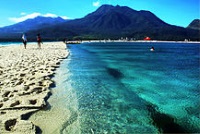
Situated on the north coast of Mindanao, the tiny island of Camiguin is renowned for the friendliness of its people. It's also distinguished for having more volcanoes than municipalities. Regarding its attractions, the destination is a relaxation seekers paradise, where hot springs and stunning beaches are the order of the day. Visitors can climb Mount Hibok-Hibok, and snorkel through a sunken cemetery too, reading gravestones that were submerged in a volcanic eruption. Culture lovers should stop at some of the island's remaining colonial homes, buildings and churches. Santa Rosario Church in Sagay, and the San Nicolas de Tolentino Church in Mambajao are among the island's best churches.
Website : www.camiguin.gov.ph
Transport : There is regular sea and air transportation available from Cebu
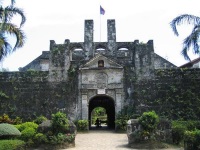
Located in Cebu City's wharf area, Fort San Pedro was the centre of the country's first Spanish settlement. Established in 1565, it began as a single triangular bastion, and was expanded and fortified over the next 200 years. The fort has also served a variety of purposes, seeing use as a watch-tower to counter pirate attacks in the 1700s, a prison for local rebels during the Philippine Revolution, and a US army barracks. Today, the fort has been turned into a museum park, where visitors can encounter the island's history. The small, well-preserved site often hosts cultural events, and student guides are usually on hand to show travellers around and provide background. Tours are free, though tips are appreciated.
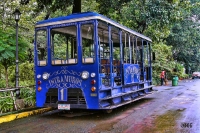
Intramuros is one of the oldest parts of Manila. Located on the southern bank of the Pasig River, the walled Spanish enclave is a feast of historic buildings and churches, many of which are being or have been restored. Tourists can enjoy several parks, restaurants, art galleries, and souvenir shops in the attractive area. They may also find the area's history interesting. For instance, political prisoners were held, tortured and sometimes executed at Fort Santiago. Today, it is a lush park full of homing pigeons and flowering trees, where visitors can ride along the promenade in a horse-drawn carriage. History lovers should stop at the beautifully restored colonial residences in the Barrio San Luis as well. The area has a festive atmosphere and is full of street artists and stalls selling food.
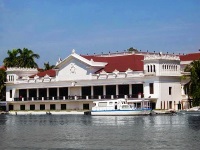
The Malacañan Palace is the seat of government and official residence of the Philippines head of state. Situated on the north bank of the Pasig River, the villa has been a noble residence since the 1800s, when it was built for a Spanish aristocrat. Before that, it was a humble place for fisherman. The Spanish Government bought the property as a summer house for its Governor General in 1825, though it later became the head of state's permanent seat. Today, visitors will find a museum in the palace. The institution features national treasures, historical artefacts, and mementos from each of the Philippines' presidents, including the notorious Ferdinand and Imelda Marcos, who ruled as authoritarian dictators. The building itself is very attractive and the rooms are furnished beautifully. Visitors can enjoy great views over the river from some of the windows. Guided tours are compulsory and very informative. Photography is permitted, though visitors are obliged to register their cameras at the entrance. Also, the number of cameras per group is sometimes limited. Visitors may have to go through security checks.
Address : Malacañan Palace, JP Laurel Street, San Miguel, Manila, Metro Manila, Philippines.
Website : http://malacanang.gov.ph/
Telephone : +63 2 784 4286
Opening times : Tuesday to Sunday, 8am until 6pm.
The National Museum and Art Gallery of the Philippines showcases the cultural, natural and historical heritage of the islands. The large and comprehensive institution categorises its exhibits in five divisions, namely art, botany, zoology, geology and anthropology. Visitors will find the archipelago's oldest human remains in the museum's collection. They can also view the remains of the San Diego Spanish galleon, which sank in Philippine waters in 1600. Though reportedly short on funding, the institution is clean, well-kept and has good facilities. Photography is permitted, but not with flash. All things considered, the deeply interesting museum is a worthwhile stop for travellers of all ages.
Address : Padre Burgos Ave, Ermita, Manila, Metro Manila, Philippines.
Website : www.nationalmuseum.gov.ph
Telephone : +63 2 527 7889
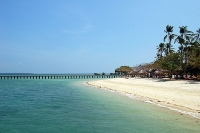
The island of Palawan stretches from Luzon towards Malaysia. Thickly forested and accented by coves, beaches, lagoons and limestone cliffs, the gorgeous region is a must for nature lovers. Puerto Princesa is the primary gateway to the island. Most travellers head north after arriving in the coastal city. That said, the Puerto Princesa area has many hiking and spelunking opportunities, and the underground river near Sabang is certainly worth visiting. Travellers will find El Nido in the north. The small, lively beach town is Palawan's most popular destination, and is geared towards island hopping. It also has plenty of places to eat out and buy local handicrafts. From El Nido, travellers can choose to take a boat to the neighbouring island of Busuanga and the town of Coron. They will find fewer niceties than on Palawan's main island, but can explore the island's gorgeous aquamarine lakes, and experience some of the best scuba diving in the region. Indeed, the island's Tubbataha Reef is extremely important to the Philippines from an ecological point of view, given that it's a feeding ground and nursery for marine life. The area is archaeologically significant too, as palaeolithic remains have been discovered on the island. They date back approximately 22,000 years.
Website : www.palawan.gov.ph
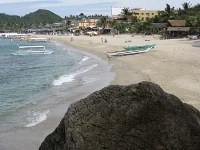
Located on the island of Mindoro, Puerto Galera began as a refuge for Spanish traders in the 16th century. Today, the 'Port of Galleons' consists of several towns and beach resorts, which together form one of the country's largest urban areas. A UNESCO programme declared Puerto Galera a protected area in the 1970s. This put the area on the tourist map and helped the cause of its coral reefs and marine life - which had been suffering because of dynamite fishing. Puerto Galera is now one of the most sought-after scuba diving locations in the world. Travellers will find many sites within 10 minutes of the three main beaches, where they can explore wrecks, deep trenches and vibrantly colourful reefs. Sabang and White Beach offer an active nightlife. Visitors who want a less-crowded experience should head to one of the island's smaller coves or beaches.
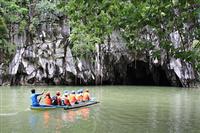
The Puerto Princesa Subterranean River National Park is located in the province of Palawan, and lies about 36 miles (58km) north of Puerto Princesa. Regarded as one of the New Seven Wonders of Nature, the underground river sees a significant number of tourist visits. Travellers can choose from many tour operators. The well-maintained National Park is part limestone karst mountain landscape, and the famed river follows a five mile (8km) course through a large cave complex. Ultimately, it merges with the South China Sea. Visitors will enjoy a guided boat ride through the cave complex, which includes fascinating rock formations and a lively bat population.
Website : www.puerto-undergroundriver.com
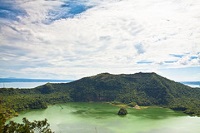
Tagaytay is one of the most-visited tourist destinations in the Philippines. Located just south of Manila, the town's most famous attraction is the Taal Volcano, which sits on an island in a lake. The volcano has another lake within its vast crater. Filipinos regard Tagaytay as their 'summer capital', with many of them heading there to escape Manila's challenging summer heat. The area provides many recreational opportunities, and has some top hotels and restaurants. Travellers can also visit the 'Palace in the Sky': an unfinished complex that was originally meant to be a home for former president Marcos. Instead, it serves as a park and viewpoint. The area's huge flower farm is worth stopping at, too. Golfing, diving, horse riding, snorkelling and ziplining are among the activities on offer.
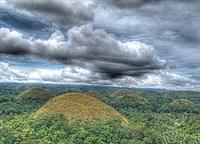
The Chocolate Hills are Bohol Province's most famous tourist attraction, and are widely regarded as one of the top 10 things to see in the country. Nature lovers will enjoy the area's conical hills, which number somewhere between 1200 and 1800. The geological marvels were formed from grass-covered limestone and turn chocolate-brown near the end of the dry season (April or May). At this time, they start to resemble enormous molehills. The UNESCO World Heritage Site is among the most alien landscapes travellers will encounter on earth. An excursion to the Chocolate Hills is a must for anyone on holiday in the Philippines. Travellers should note that climbing up to the viewing platform means scaling a steep stairway, which may be tiring for the unfit or the elderly. It's well worth the effort, though. The hills are particularly lovely in the early morning hours or at sunset.
Website : www.chocolatehills.net

Travel Guide powered by Word Travels, copyright © 2023 Globe Media Ltd. By its very nature information in this travel guide is subject to change at short notice and travellers are urged to verify information on which they're relying with the relevant authorities. Neither Globe Media Ltd nor Travel Vogue can accept any responsibility for any loss or inconvenience to any person as a result of information contained above.